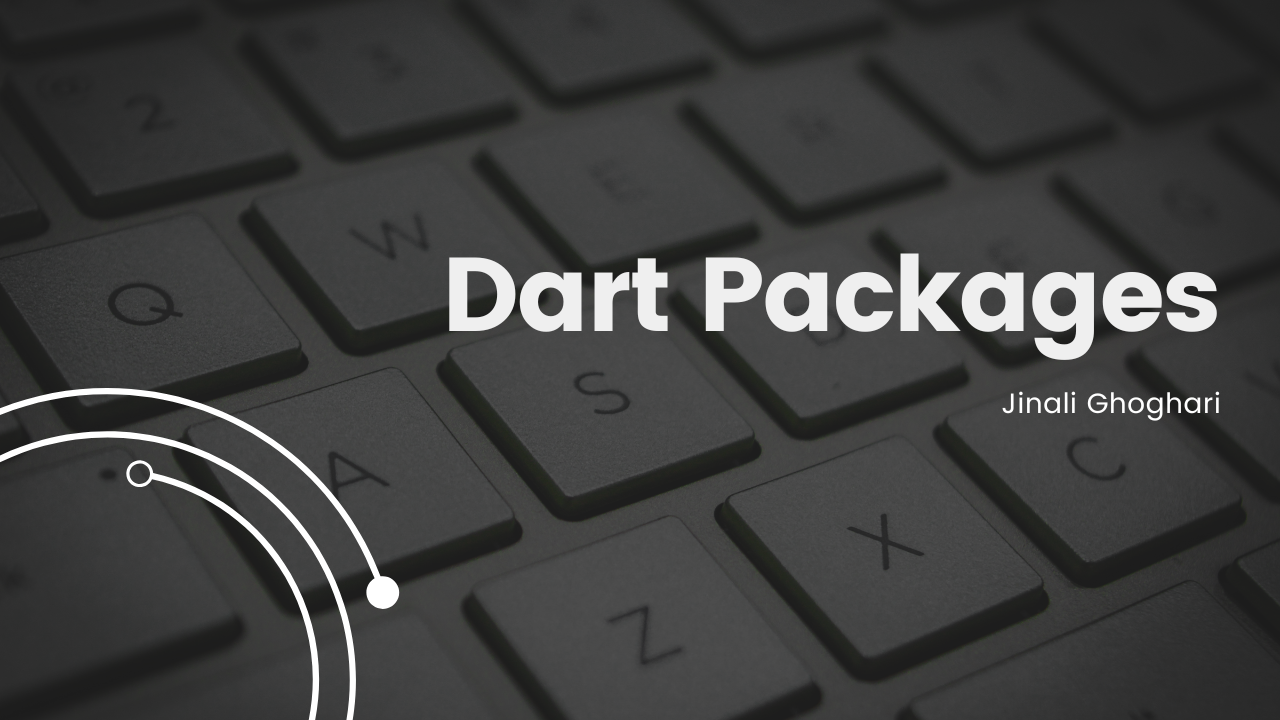Dart Packages
 Jinali Ghoghari
Jinali Ghoghari
In simple terms, Dart packages are collections of reusable code that are created by developers to help others solve common problems or perform specific tasks when building applications with the Dart programming language.
Think of Dart packages like toolkits or sets of instructions that you can easily use in your Dart projects. Instead of writing the same code over and over again, you can find a package that already does what you need, and you can simply include it in your project. This can save you time and effort because you don't have to reinvent the wheel.
For example, if you need to work with dates in your Dart application, you might find a date-handling package that provides pre-written code for common date-related tasks. You can include this package in your project, and then use its functions without having to write all the code yourself.
Dart packages are shared with the Dart community through a package manager called "pub." Pub makes it easy for developers to discover, download, and use packages in their projects. It's a way for the Dart community to collaborate and build on each other's work, making it faster and more efficient to create Dart applications.
How to use
Dart packages is a straightforward process, and it typically involves the following steps:
Find a Package: Identify the Dart package that provides the functionality you need. You can explore Dart packages on the official Dart package repository called pub.dev. Search for packages based on keywords or browse through categories.
Install the Package:
Once you've chosen a package, you need to add it to your Dart project. Open your project's pubspec.yaml file.
In the dependencies section, add the package name and the version you want. For example:
yamlCopy codedependencies: my_package: ^1.2.3Here, my_package is the name of the package, and ^1.2.3 specifies that your project should use version 1.2.3 or any compatible version.
Save the pubspec.yaml file.
Fetch the Package:
In your terminal or command prompt, navigate to your project's root directory.
Run the following command to fetch the package:
pub getAlternatively, if you're using Dart's new package manager, you can run:pub get
This command downloads and installs the specified package and its dependencies.
Import and Use:
In your Dart code, import the package using the import statement. For example:
import 'package:my_package/my_package.dart';You can now use the functionality provided by the package in your code.
Here's a simple example using a hypothetical package for handling dates:
import 'package:date_utils/date_utils.dart';
void main() {
DateTime now = DateTime.now();
DateTime nextWeek = Utils.addDays(now, 7);
print('Today: $now');
print('Next week: $nextWeek');
}
Remember to check the package documentation for specific usage instructions and examples. The documentation is usually available on the package's pub.dev page or on the package's GitHub repository.
Always be mindful of the package versions you specify in your pubspec.yaml file to ensure compatibility and stability within your project.
Commonly used packages
Dart has a vibrant ecosystem with numerous packages that cater to a variety of needs. Here are some commonly used Dart packages across different domains:
- http: This package provides functions for making HTTP requests and handling responses. It is widely used for networking and interacting with APIs.
dependencies:
http: ^0.13.3
intl: For internationalization and localization, the intl package is often used. It helps with formatting dates, numbers, and strings based on different locales.
dependencies: intl: ^0.17.0shared_preferences: This package is used for persisting simple data in key-value pairs on the device. It's commonly employed for storing settings or small amounts of data.
dependencies: shared_preferences: ^2.0.9provider: For state management, the provider package is frequently used. It's a simple and effective way to manage and listen to changes in state.
dependencies: provider: ^6.1.6sqflite: When working with local databases on mobile devices, the sqflite package is popular. It provides a simple SQLite database implementation.
dependencies: sqflite: ^2.0.0+3flutter_bloc: This package is part of the Bloc state management pattern. It helps organize code and manage the state of a Flutter application.
dependencies: flutter_bloc: ^7.4.0dio: Similar to the http package, dio is used for making HTTP requests. It provides additional features like request/response interceptors and easy cancellation.
dependencies: dio: ^4.0.0flutter_svg: For working with Scalable Vector Graphics (SVG) in Flutter, the flutter_svg package is widely used.
dependencies: flutter_svg: ^0.22.0url_launcher: This package simplifies the process of launching URLs, emails, and making phone calls from a Flutter app.
dependencies: url_launcher: ^6.0.13firebase_core and firebase_auth: When integrating Firebase services into a Flutter app, these packages are fundamental. firebase_core initializes Firebase, and firebase_auth is used for user authentication.
dependencies: firebase_core: ^1.10.6 firebase_auth: ^4.5.0
Remember to check the official documentation for each package for the latest versions and usage instructions. Additionally, explore the pub.dev website for a comprehensive list of Dart packages: pub.dev.
Creating packages
Creating Dart packages is like putting together little bundles of code that can be easily shared and reused. It's a way to organize your code into neat and convenient packages so that others (or even your future self) can easily use them in their Dart projects. Think of it as creating a gift-wrapped box of functionality that can be easily shared with the Dart community.
Package Initialization:
- You organize your date-handling code into a dedicated folder within your Dart project.
// Inside your project folder
/my_project
/lib
/date_package
date_handler.dart
pubspec.yaml Configuration:
- In the main project folder, you create a file named
pubspec.yaml. This file contains metadata about your package.
- In the main project folder, you create a file named
name: my_date_package
version: 1.0.0
description: A Dart package for handling dates.
Making it a Package:
- You run the command
dart pub publishin your project directory to publish your package.
- You run the command
dart pub publish
Using the Package:
- Other Dart developers can now easily use your date-handling package in their projects.
// In another Dart project
// pubspec.yaml
dependencies:
my_date_package: ^1.0.0
import 'package:my_date_package/date_handler.dart';
void main() {
var today = DateHandler.getCurrentDate();
print(today);
}
So, creating a Dart package is essentially about packaging your code neatly, describing it in a pubspec.yaml file, and then sharing it with the Dart community. Other developers can then include your package in their projects, making development more modular and efficient.
Publishing Packages
Publishing a Dart package is a straightforward process that allows developers to easily use and integrate your code into their projects. Follow these simple steps to publish your Dart package:
1. Prepare Your Package:
Ensure that your package adheres to Dart's package layout conventions.
Include a well-structured
pubspec.yamlfile with relevant metadata and dependencies.
2. Versioning:
Use semantic versioning (SemVer) for version numbers (major.minor.patch).
Update the version number in your
pubspec.yamlfile.
3. Create an Account:
- Visit pub.dev and create an account if you don't have one.
4. Login to Pub.dev:
Use the Dart SDK's
pubtool to log in to your pub.dev account.pub login
5. Package Validation:
Ensure your package passes the
pubpackage validator.pub publish --dry-run
6. Publish Your Package:
If validation is successful, publish your package to pub.dev.
pub publish
7. Documentation:
Provide clear and concise documentation for your package.
Include usage examples, API references, and any other relevant information.
8. Versioning Again:
- After publishing, consider updating the version number for future releases.
9. Share and Collaborate:
Share your package with the Dart community on social media, forums, and other platforms.
Encourage collaboration and welcome feedback from other developers.
Congratulations! Your Dart package is now available for others to discover, use, and contribute to. Keep maintaining and improving your package to provide value to the Dart community.
Writing package pages
Writing Package Pages for Your Dart Package
Creating a comprehensive and well-organized package page for your Dart project on pub.dev is crucial for effectively communicating with potential users and contributors. Here's a guide on how to craft an informative package page:
1. Overview:
- Description: Begin with a concise yet informative description of your package. Clearly communicate its purpose and primary features.
2. Installation:
- Installation Instructions: Provide step-by-step instructions on how users can add your package to their Dart projects using the
pubspec.yamlfile.
dependencies:
your_package_name: ^your_version_number
3. Usage:
Getting Started: Offer a quick start guide with sample code snippets demonstrating the basic usage of your package.
Configuration: If applicable, explain any configuration settings users might need to adjust.
4. Features:
List of Features: Enumerate the key features and functionalities your package provides.
Use Cases: Describe common use cases where your package can be beneficial.
5. API Reference:
- Documentation: Link to or embed API documentation generated from your code. Provide clear explanations for each class, function, and parameter.
6. Examples:
Usage Examples: Include additional code examples that showcase different aspects of your package's capabilities.
Demo Code: If applicable, provide links to or embed demo applications that use your package.
7. Versioning:
- Changelog: Maintain a clear and up-to-date changelog that outlines the changes in each version of your package.
Issue Tracker: Encourage users to report issues and contribute to your project by providing a link to the issue tracker.
Community Channels: If you have a dedicated community or support channels (e.g., forums, Gitter, Discord), share the links.
9. Contribution Guidelines:
- Contributing: Outline how developers can contribute to your project. Include information on submitting bug reports, feature requests, and pull requests.
10. Licensing:
- License Information: Clearly state the license under which your package is distributed.
11. Badges:
12. Author Information:
Contact: Offer a way for users to reach out for support or collaboration.
Remember, a well-crafted package page not only attracts users but also helps build a supportive and engaged community around your Dart package.
Subscribe to my newsletter
Read articles from Jinali Ghoghari directly inside your inbox. Subscribe to the newsletter, and don't miss out.
Written by
